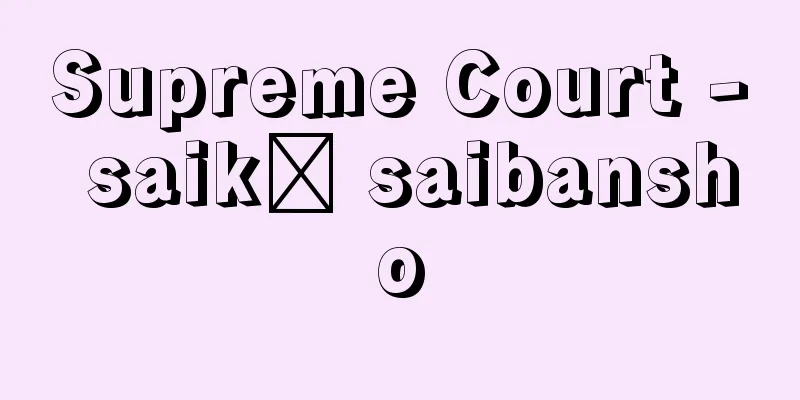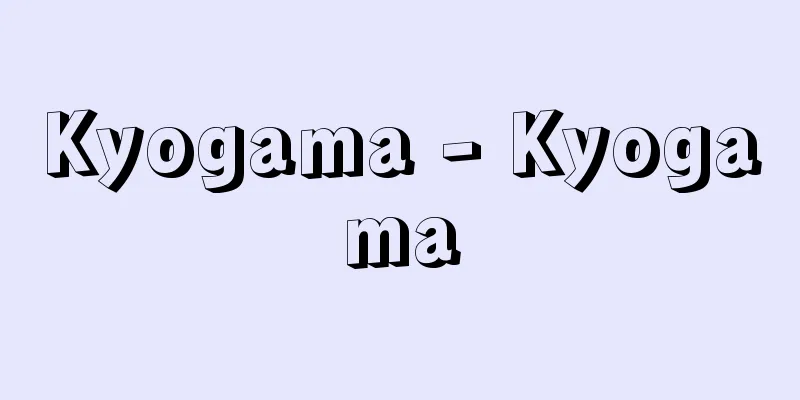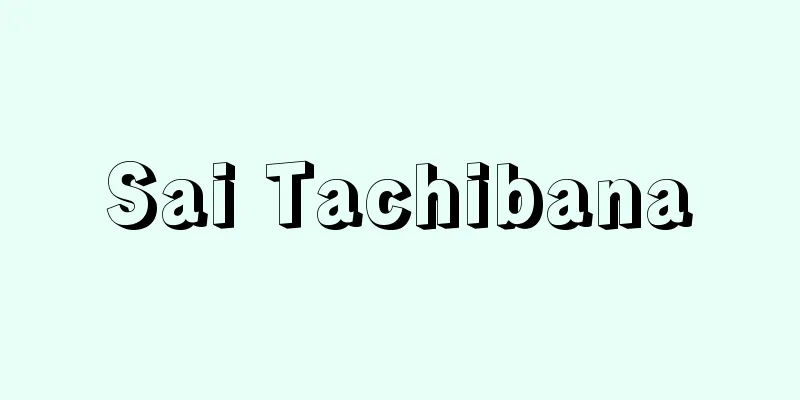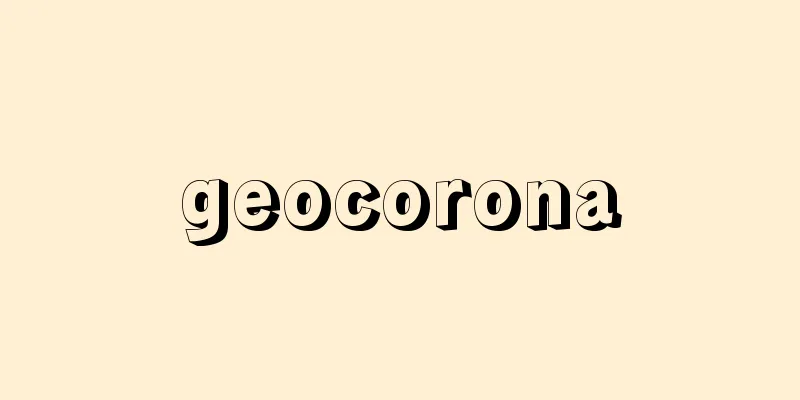Supreme Court - saikō saibansho

|
The highest organ of the state responsible for judicial power. It is abbreviated as the Supreme Court. Unlike lower courts, the establishment of the Supreme Court was authorized directly by the Constitution of Japan (Article 76 of the Constitution), and formally corresponds to the Daishin-in (Great Court of Justice) of the Meiji Constitution era, but it has a much higher status and broader authority. The Supreme Court is located in Tokyo (Article 6 of the Court Act). [Masaaki Ikeda] Composition of the Supreme CourtThe Supreme Court is composed of the Chief Justice and 14 other justices, who retire at the age of 70. The Chief Justice is appointed by the Emperor based on the Cabinet's nomination, and each judge is appointed by the Cabinet. In order to prevent arbitrary decisions by the Cabinet, appointments are subject to a national referendum at the first general election held after the appointment. Supreme Court hearings and trials are held in either the Grand Bench or the Petite Bench. Trials held in the Grand Bench are for determining unconstitutionality, changing Supreme Court precedents, and when the opinions of the Petite Bench judges are split and the number of judges is equal. [Masaaki Ikeda] authorityAs the sole court of final appeal, it has jurisdiction over appeals and special appeals, and as the highest judicial organ, it has the power to review legislation for constitutionality (power to review statutes), the power to make rules, the power to appoint lower court judges, and the power to supervise the administration of judicial power. The power to review unconstitutional legislation ultimately serves as a "guardian of the Constitution" by examining the constitutionality of laws, orders, regulations, and administrative actions through specific litigation, thereby protecting the Constitution and ultimately guaranteeing fundamental human rights. In addition to its status as the court of last resort, the Constitution also gives the Supreme Court the power to control judicial power and administration. That is, the power to lay down rules on litigation procedures, lawyers, internal discipline of the courts, and matters related to the administration of judicial affairs (Article 77 of the Constitution), which is called the rule-making power. The Constitution also gives the Supreme Court the power to nominate lower court judges, and the Cabinet makes such appointments from a list compiled by the Supreme Court (Article 80, paragraph 1 of the Constitution), ensuring the independence of the judicial power. In addition, the Supreme Court is granted the power to appoint and dismiss court officials other than judges (Article 64 of the Court Act), the power to prepare a budget for court expenses (Article 83 of the same Act), and the power to supervise the administration of judicial power (Article 80 of the same Act). These powers are not judicial power itself, but belong to the judicial administration, but they help to ensure the independence of the judicial power. [Masaaki Ikeda] Affiliated OrganizationsAffiliated institutions include the Judicial Training and Research Institute and the Comprehensive Training Institute for Court Officials, which were established for the research, training, and education of judges and other officials, as well as the Supreme Court Library, which is a branch library of the National Diet Library. [Masaaki Ikeda] Examples from other countriesExamples of the highest national organs in charge of judicial power in other countries include the Supreme Court in the UK, the Supreme Court of the US in the US, and the Cour de cassation in France. In the UK, the House of Lords was the highest judicial organ as a vestige of the medieval system, and the Law Lords served as the judicial nobility, but the Supreme Court was established in October 2009 as a result of the Constitutional Reform Act of 2005. In Germany, the Supreme Court is divided into five specialized courts: the Federal Court (Bundesgerichtshof), the Federal Administrative Court (Bundesverwaltungsgericht), the Federal Financial Court (Bundesfinanzhof), the Federal Labour Court (Bundesarbeitsgericht), and the Federal Social Court (Bundessozialgericht). [Masaaki Ikeda] "The Constitution and Trials" by Yoichi Higuchi and Toshio Kuriki (1988, Horitsu Bunkasha) [References] | | |Completed in April 1974. It has five floors above ground and two below, and the exterior walls of the reinforced concrete structure are covered with granite. Chiyoda-ku, Tokyo ©Yutaka Sakano "> supreme court Source: Shogakukan Encyclopedia Nipponica About Encyclopedia Nipponica Information | Legend |
|
司法権を担当する国家の最高機関をいう。最高裁と略称される。下級裁判所と異なり、日本国憲法により直接に設置を認められ(憲法76条)、形式的には、明治憲法時代の大審院に対応するが、はるかに高い地位と広い権限が与えられている。最高裁は東京都に置かれている(裁判所法6条)。 [池田政章] 最高裁の構成最高裁判所長官と14名の最高裁判事により構成され、70歳で定年退職する。長官は内閣の指名に基づき天皇が任命し、各裁判官は内閣が任命する。任命について内閣の専断を防止するため、任命後初めて行われる総選挙の際に、国民審査に付される。最高裁の審理や裁判は、大法廷または小法廷で行われる。大法廷で行われる裁判は、違憲問題の判断と、最高裁の判例変更のほか、小法廷の裁判官の意見が二つに分かれ、その数が同数の場合などである。 [池田政章] 権限唯一の終審裁判所として、上告および特別抗告について裁判権を有するほか、司法権の最高機関として、違憲立法審査権(法令審査権)、規則制定権、下級裁判所裁判官の指名権、司法行政についての監督権、を有する。 違憲立法審査権は、具体的な訴訟を通じて、最終的に法律、命令、規則、処分の憲法適合性を審査し、憲法を守り、ひいては基本的人権の保障を図る「憲法の番人」としての役割を果たすものである。 さらに、憲法によって、単に終審裁判所たる地位のほか、司法権および運営に関する統制権的権限が与えられている。すなわち、訴訟に関する手続、弁護士、裁判所の内部規律および司法事務処理に関する事項について規則を定める権能(憲法77条)で、規則制定権とよばれる。また、下級裁判所裁判官の指名権が与えられ、その任命は最高裁の作成する名簿により内閣が行う(憲法80条1項)ことが定められており、司法権の独立の確保が図られている。このほか、最高裁には、裁判官以外の裁判所職員の任免(裁判所法64条)、裁判所の経費についての予算作成上の権限(同法83条)、および司法行政の監督権(同法80条)などが認められている。これらの権限は、司法権そのものではなく、司法行政権に属するが、司法権の独立の保障に役だっている。 [池田政章] 付属機関付属機関としては、裁判官などの研究・修養・養成のために置かれた司法研修所、裁判所職員総合研修所のほか、国会図書館の支部図書館としての最高裁判所図書館がある。 [池田政章] 諸外国の例司法権を担当する国家の最高機関の例を諸外国でみると、イギリスでは最高裁判所Supreme Court、アメリカでは合衆国最高裁判所Supreme Court of the U. S.、フランスでは破毀院(はきいん)Cour de cassationがこれにあたる。イギリスではこれまで中世的制度の名残(なごり)として貴族院House of Lordsが司法の最高機関とされ、法律貴族Law Lordがその任にあたっていたが、2005年の憲法改革法によって最高裁判所が2009年10月に誕生した。また、ドイツの最高裁判所は五つの専門別に分かれ、通常裁判所たる連邦裁判所Bundesgerichtshofのほか、連邦行政裁判所Bundesverwaltungsgericht、連邦財政裁判所Bundesfinanzhof、連邦労働裁判所Bundesarbeitsgericht、連邦社会裁判所Bundessozialgerichtがそれである。 [池田政章] 『樋口陽一・栗城寿夫著『憲法と裁判』(1988・法律文化社)』 [参照項目] | | |1974年(昭和49)4月完成。地上5階、地下2階建てで、鉄筋コンクリート造の外壁を花崗岩で覆ってある。東京都千代田区©Yutaka Sakano"> 最高裁判所 出典 小学館 日本大百科全書(ニッポニカ)日本大百科全書(ニッポニカ)について 情報 | 凡例 |
<<: Local merchant - Zaigō Shōnin
>>: Maximum and minimum thermometer - Saikou Saitei Ondokei
Recommend
Miserabilism (English spelling)
…Born in Paris. Having experienced the horrors of...
Sogetsu School
A school of ikebana. It was founded by Teshigahara...
American style whaling
...On the other hand, dolphin hunting has been ac...
James I - James
King of England (reigned 1603-1625). King of Scotl...
octave
〘noun〙 (octave) (from the Latin for eight) The eig...
Feder
Belgian-born French film director. His works inclu...
Arrowroot - Arrowroot (English spelling)
An evergreen perennial plant of the Arrowroot fam...
Shiban
… [Ethnic History] The word özbek first appears i...
Grass Clover - Grass Clover
An insect belonging to the family Tettigoniidae i...
Hillerød (English spelling)
…A castle on three islands in a lake in Hillerød,...
Tibetan mastiff
…It is a guard dog that originated in Tibet. Mast...
County of Aragon
…The Ebro River is important to the local economy...
Oi Juujiro - Ooi Juujiro
… The changes in individual cities or cities belo...
The Human Pavilion Incident
From March to July 1903 (Meiji 36), a show tent ca...
Agricultural culture
Refers to the general lifestyle and culture of hu...









